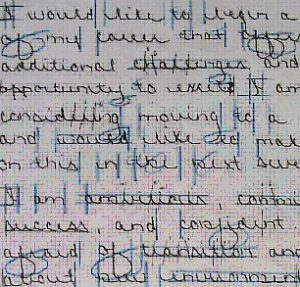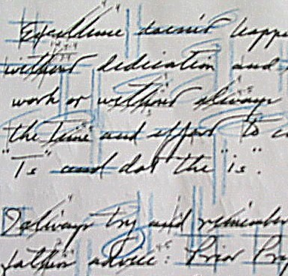Graphology Defined and How it Works: Graphology is defined as the scientific study of handwriting to determine personality traits. Since the 17th century, researchers have linked human character to handwriting patterns. Graphology is an empirical science that offers a direct link to human personality. The conscious and subconscious minds are revealed through hundreds of handwriting aspects by the complex coordination of nerves, body, and mind function. It could more accurately be referred to as “mind writing.” Your writing is as unique as your fingerprints. Handwriting is an expression of the true self.
Graphology is so informative because it reveals subconscious character, the real personality, not just the persona and the one seen when a person is at his or her best.
Addressing Handwriting Analysis Skepticism
5 Possible Ways to Understand and Outmaneuver Your Enemy
Handwriting Analysis is More Effective Than Self-report Personality Tests: The problem with fill-in-the-blanks and multiple choice question personality tests, the self-report kind, is that the person who is taking the test inevitably figures out the intent of the questions and answers how he or she thinks they should answer to score appropriately.
Whether is it to obtain a job, advance within a company, or for some other reason, the questions aren’t always answered honestly.
Everyone wants to present themselves in the best light possible and since self-report tests can be manipulated, a more objective alternative is necessary.
Self-report personality tests are best used as supplements to other, more reliable forms of assessment, such as handwriting analysis.
Handwriting analysis is so useful because the results can’t be manipulated, it helps save you the hassle and expense of hiring the wrong employees, and it’s an effective tool to help improve workplace morale and productivity by identifying true strengths, challenges, and compatibility.
The U.S. Library of Congress catalogues graphology (handwriting analysis) books in the psychology, document examination, and personnel screening categories.
“Graphologist” (handwriting analyst) is listed in the U.S. Department of Labor’s Directory of Occupational Titles (DOT) as “miscellaneous professional.”
Handwriting Analysis- 6 Concerns Addressed
5 More Handwriting Analysis Concerns Addressed
In Support of Handwriting Analysis

History
Interest in the connection between handwriting and personality dates back to over 2000 years ago. Aristotle remarked, “Spoken words are the symbols of mental experience and written words are the symbols of spoken words. Just as all men do not have the same speech sounds, so do all men not have the same writing.”
In 1622 Italian scholar Camillo Baldi published the first book on handwriting analysis, “How to Judge the Nature and the Character of a Person From His Letter.”
The term graphology was coined in 1875 by two French priests, Abbe Flandrin and Jean-Hypolyte Michon. Their publications on handwriting analysis in the late 1800s were the most scholarly and in-depth work done up to that time; their research contributed greatly to the field of handwriting analysis.
Discrimination and Graphology
Graphology has been used regularly in U.S. courts since the late 1800s. Legal precedents have been set regarding handwriting analysis. One court ruled that handwriting is “behavior in public” and that using it as the basis of personality analysis cannot be judged as an invasion of privacy. U.S. vs. Hazelwood School District 534 F 2nd 805 states that graphology is “not precluded in hiring if it is related to the job.” A graphologist is unable to distinguish age, race, sex, and marital status from a handwriting sample. Graphology is probably the most non-discriminatory method of personality profiling in existence today.
Application of Graphology
Graphology can be used to identify personality strengths and challenges, to determine reliability, to display ability, talent, and intelligence, as a hiring tool–it allows you to select the right person for the job, to evaluate management or sales potential, to evaluate compatibility, to understand management or sales style, to detect leadership ability, to evaluate employees for promotions, as a tool for career guidance, as an aid in negotiations, and in numerous other ways.
It’s also interesting to note that handwriting analysis can identify if a person is blocking prosperity in their life. Although a person may consciously feel that they deserve more abundance, their subconscious (which dominates the conscious mind) may feel like they don’t deserve it, thus they unconsciously sabotage circumstances in their lives that equate to having more money. The same dynamic applies to other areas in life, including relationships.
Relating to romantic relationships, a good handwriting analysis can tell you if a person fears commitment, avoids conflict, lacks a good sense of discernment (necessary to identify and understand personality and relationship issues), is emotionally mature or immature, is impulsive, fears intimacy, is restless, is self-conscious, lacks self-esteem and ego strength, has an excessive interest or disinterest in sex, fears success, fears trusting others, has a tendency to withdraw, and much more.

Graphology Q&A
Q: Who uses graphology?
A: Graphology is more extensively used by European and Israeli businesses than by American organizations. It’s common for major corporations in Italy, Spain, France, and Israel to regularly use graphology for personnel selection. American companies that use it include giants like G.E., Ford, Pepsi, Northwestern Mutual Life, Quaker Oats, Dairy Queen, H&R Block, and many smaller companies. Also, personal usage of graphology has empowered countless individuals with profound personality and compatibility awareness.
Q: What are some other uses of graphology?
A: Some other uses of graphology include the following: use it to decide which person to hire as your accountant, who you should hire as your baby-sitter, who you should go into business with, who you should date, who you should trust, and innumerable other applications. It can also be used, among other ways, for family relations, group dynamic analysis, self-help, personal growth, and to help modify personality traits through a process called graphotherapy involving handwriting exercises. Although a graphologist must be very careful to avoid suggesting handwriting alterations that tinker with personality defenses or those that signify excessive character modifications, it is possible to change subconscious programming to some degree through altering handwriting.
Q: What are some of the personality traits that graphology identifies?
A: Graphology is extremely reliable in revealing information about personality traits and it is also very useful in compatibility analysis. The following are some of the personality areas with which Scott works.
Social Skills: compliance; dependability; easygoingness; extroversion; generosity; kindheartedness; modesty; outspokenness; tolerance; and more.
Personal Dynamics: ambition; assertiveness/competitiveness; cautiousness; consistency; initiative; persistence; risk-taking; self-confidence; vitality; and more.
Intellect/Mentality: abstract thinking; analytical ability; clear thinking; conservative thinking; decision making ability; future-orientation; idealism; imagination; logical thinking; original thinking; past-orientation; present-orientation; visionary thinking; and more.
Communication Skills: communicate, desire to; diplomacy; discretion; empathy; listening ability; persuasiveness; rapport; verbal facility; and more.
Motivations: material/financial; ego needs; personal accomplishment; leadership; approval; constructive challenge; social involvement; practical interests; security; knowledge/theory; creativity; pleasure; and more.
Work Habits: ability to deal with repetitive tasks; attention to detail; concentration; determination; independence; objectivity; organizational skills; problem-solving ability; simplification of issues; team player; time management and more.
Q: How does a well-trained graphologist provide accurate personality profiles?
A: Accuracy in graphology demands that the context of the entire writing sample be considered and that all individual aspects and parts of the script must be interpreted independently and then built into a complete picture describing the personality. The collective body of traits in a handwriting sample (over 300 in all) either supports and intensifies, or mitigates the energy of any one individual aspect.
Q: How accurate is graphology?
A: Handwriting analysis can’t reveal everything. It can’t always predict the attitude a person will take or the exact choices they will make. Graphology does show, however, how a person acts, feels and thinks. It symbolizes a person’s state of mind and personality at the time of writing, signifies past behavior and shows potential for future conduct. It is important to note that no single form of personality analysis is 100% accurate. Well-trained graphologists typically offer at least 80% accuracy in personality analysis.
Q: Is it true you can effectively analyze character from a signature?
A: Trying to analyze handwriting accurately from a signature alone is like trying to describe what a person looks like based on a photo of only their eyes.
Q: How much handwriting does a graphologist need to do an analysis?
A: It is best if the analyst has at least a page of handwriting to work with. The sample should be dated, written spontaneously on unlined paper with a ballpoint pen and then signed at the end. If the person usually prints, at least a paragraph of cursive should be written.
Q: What are some of the aspects in a handwriting sample that a well-trained graphologist considers?
A: The following are some important aspects to consider when analyzing a handwriting sample: baseline; capitals; connectives; connectivity; consistency; contradictions in script; compression; contraction/expansiveness; down-strokes; ductus; elaboration; expansion; finals; fluidity; form; harmony; hooks; jabs; knots; lead-ins; legibility; loops; margins; movement; organization; originality; personal pronoun I; pressure; retracing; rhythm; shading; signature; simplicity; size; slant; overall arrangement and picture of space; letter, word and line spacing; speed; spirals; tension; ties; zonal balance and much more.
Q: Have any accredited scientific studies been done involving handwriting analysis?
A: Yes. Below are some instances of scientific research regarding graphology:
Broern, W. Graphology and Its Importance In Current Medical Psychology; Medizinische Klinik, Hamburg, 66, 6, 1971.
Hearns, R. The use of graphology in criminology; Criminal Psychopathology, 3, 461-464, 1972.
Ianetta, Kimon and Reed Hayes, James F. Craine, Ph.D. & Dennis G. McLaughlin, Ph.D. Facilitating Assessment of Dangerousness by Using Characteristics of Handwriting; Hawaii, 1992.
Nevo, Baruch. National Institute of Testing & Evaluation, University of Haifa. Graphology Validation Studies in Israel: Summary of 15 years of Activity; International Association for Applied Psychology, Jerusalem, July, 1986.
Nevo, Baruch. Yes, graphology can predict occupational success: Rejoinder to Ben Shakhar, Et Al; Perceptual and Motor Skills, 66, 92-94, 1988.
Pearl, R. The value of handwriting in neurological examination; The Mount Sinai Journal of Medicine, 41, 1, 200-2004, 1974.